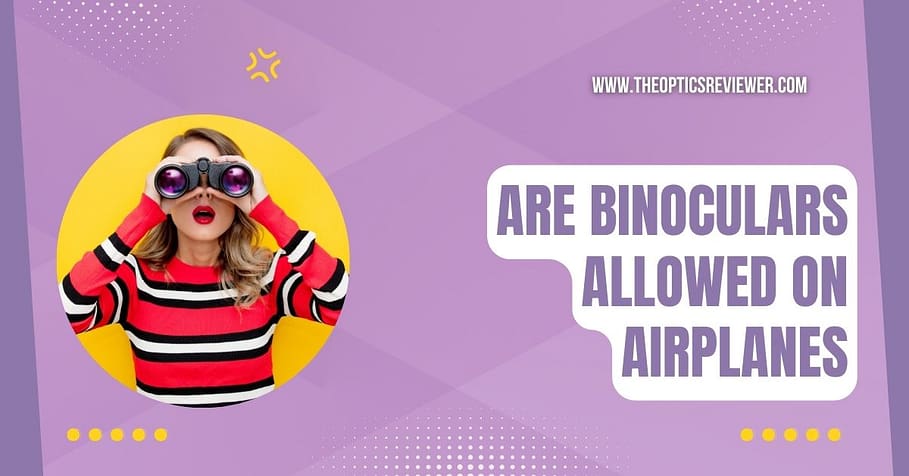Embarking on a journey and wondering, Are binoculars allowed on airplanes? The excitement of travel often comes with a desire to capture breathtaking moments, and binoculars play a crucial role. In this guide, we unravel the regulations surrounding bringing binoculars aboard airplanes.
Whether you’re a birdwatcher, a sports enthusiast, or a nature lover, understanding the rules ensures a seamless travel experience. We delve into airline policies, cabin restrictions, and the best practices for carrying your optical companions. Stay tuned to unlock the secrets of hassle-free air travel with your binoculars, enhancing your explorations from takeoff to landing.
Contents
- 1 Key Takeaways
- 2 Are Binoculars Allowed on Airplanes?
- 3 Are Binoculars Allowed on Airplanes in Checked Baggage?
- 4 How to Pack Binoculars in Checked Luggage?
- 5 What Happens If TSA Catches You With Binoculars?
- 6 Are Binoculars Considered Dangerous on a Plane?
- 7 Safe Travel Tips For Your Binoculars
- 8 Are There any Restrictions on the Number of Binoculars that Can be Carried on an Airplane?
- 9 Conclusion
- 10 References
- 11 Frequently Asked Questions
- 11.1 Can I Bring Binoculars in My Carry-On Luggage?
- 11.2 Are There Any Size Limitations for Binoculars Allowed on Airplanes?
- 11.3 Do I Need to Declare My Binoculars at the Airport Security Checkpoint?
- 11.4 Are There Any Specific Regulations for International Flights Regarding Binoculars?
- 11.5 Can I Use Binoculars During the Flight or Only at the Destination?
Key Takeaways
- Binoculars are permitted in both checked baggage and carry-on luggage according to TSA regulations.
- It is recommended to pack binoculars in carry-on luggage to prevent damage.
- Follow specific packing instructions provided by the TSA and check airline regulations for size and weight restrictions.
- Carrying prohibited items can result in fines, penalties, or legal action, so familiarize yourself with the TSA’s list of prohibited items and double-check your bags to avoid carrying them.
Are Binoculars Allowed on Airplanes?

Are Binoculars Allowed on Airplanes in Checked Baggage?
Binoculars are permitted in checked baggage on airplanes, in accordance with the Transportation Security Administration (TSA) regulations. However, it is essential to follow specific packing instructions and guidelines provided by the TSA to ensure a smooth and hassle-free travel experience.
When traveling with optics such as binoculars, it is crucial to pack them securely to prevent any damage during transit. The TSA recommends placing binoculars in a protective case or wrapping them in bubble wrap to provide cushioning. Additionally, it is advisable to remove any batteries from the binoculars and pack them separately to comply with TSA guidelines.
While binoculars are generally allowed in checked baggage, it is essential to be aware of prohibited items that may vary depending on the airline or country of travel. For instance, some airlines may have restrictions on the size and weight of checked bags, so it is advisable to check with the airline beforehand.
When passing through airport security, it is crucial to declare the presence of binoculars in your checked baggage to the security personnel. This will help avoid any confusion or delays during the screening process.
How to Pack Binoculars in Checked Luggage?
When preparing to travel with binoculars in checked luggage, it is crucial to adhere to proper packing guidelines to ensure the safety and protection of your optical equipment. Here are some packing tips to consider:
- Use a protective case: Invest in a sturdy, hard-shell case specifically designed for binoculars. This will provide maximum protection against any impacts or pressure during transit. Ensure that the case is well-padded and has a secure locking mechanism to keep your binoculars safe.
- Separate binocular accessories: Remove any detachable parts or accessories from your binoculars, such as lens caps, straps, or tripod adapters. Pack them separately in a small pouch or zip-lock bag to prevent them from scratching or damaging the main device.
- Maximize space: To make the most efficient use of space in your checked luggage, consider collapsing the binoculars if they have a foldable design. Additionally, you can use soft items like clothes or socks to cushion the binoculars within the case and prevent any movement.
Always check the specific airline regulations regarding the transportation of binoculars in checked luggage to ensure compliance. By following these packing tips, you can travel with peace of mind, knowing that your binoculars are well-protected and ready for your next adventure.
What Happens If TSA Catches You With Binoculars?
If a passenger is found with binoculars during the TSA screening process, the appropriate protocol will be followed by the security personnel. TSA regulations regarding binoculars state that they are allowed in both carry-on and checked luggage. However, it is important to note that carrying prohibited items on an airplane can have serious consequences.
Consequences of Carrying Prohibited Items
- Passengers may face fines, penalties, or even legal action if caught with prohibited items such as weapons or explosives.
- Carrying prohibited items can cause delays and inconvenience for other passengers as security personnel must perform additional screening procedures.
- It can also lead to unnecessary stress and anxiety for the passenger involved.
How to Avoid Getting Caught with Prohibited Items?
- Familiarize yourself with the TSA’s list of prohibited items and ensure you do not have any of them in your possession.
- Carefully pack your bags and double-check them before heading to the airport to ensure you have not accidentally packed any prohibited items.
- Pay attention to the TSA’s guidelines regarding liquids, gels, and electronics, as these items are subject to specific restrictions.
Alternatives to Binoculars for Airplane Travel
- Consider using compact or travel-sized binoculars that are specifically designed for air travel and comply with TSA regulations.
- Utilize zoom lenses or telephoto lenses on your camera or smartphone as an alternative to binoculars.
- Use digital binoculars or apps that simulate binoculars on your electronic devices.
Are Binoculars Considered Dangerous on a Plane?
Binoculars are not considered dangerous items on a plane, as long as they are used responsibly and comply with TSA regulations. When it comes to binoculars safety on airplanes, it is important to follow the guidelines set by the Transportation Security Administration (TSA) to ensure a smooth and hassle-free travel experience.
According to TSA regulations, binoculars are allowed in both carry-on and checked baggage. However, it is important to note that certain types of binoculars may be subject to additional screening procedures at the security checkpoint. It is advisable to pack them securely and keep them easily accessible during the screening process.
While binoculars are generally allowed on planes, it is important to be aware of other prohibited items that may be associated with them. For example, if your binoculars have a built-in laser pointer, the laser pointer function may be considered a separate prohibited item due to potential safety concerns. If interested read more about when were binoculars invented.
Safe Travel Tips For Your Binoculars
When traveling with binoculars, it is essential to follow certain safety precautions to ensure a secure and hassle-free journey. Here are three safe travel tips for your binoculars:
- Travel accessories: Invest in a sturdy carrying case or bag specifically designed for binoculars. This will provide protection against accidental bumps and drops during travel. Additionally, consider purchasing lens covers and a strap to keep your binoculars secure and easily accessible.
- Binoculars maintenance: Before your trip, inspect your binoculars for any damage or loose parts. Clean the lenses with a microfiber cloth and use a lens cleaning solution if necessary. Avoid using any harsh chemicals or abrasive materials that could damage the lenses or coatings. Proper maintenance ensures optimal performance during your outdoor adventures.
- Choosing the right binoculars: Depending on your travel destination and activities, select binoculars that suit your needs. For outdoor activities like hiking or birdwatching, choose compact and lightweight binoculars with a wide field of view. If you’re planning wildlife watching, opt for binoculars with a higher magnification power and superior low-light performance.
If interested read more about what is field of view in binoculars.
Are There any Restrictions on the Number of Binoculars that Can be Carried on an Airplane?
Airlines generally allow passengers to bring binoculars in their carry-on luggage, but the number of binoculars permitted may vary depending on the airline and its policies. TSA regulations in the United States, for instance, don’t specifically limit the number of binoculars a passenger can carry, as long as they fit within the carry-on baggage guidelines.
However, it’s essential to check with the specific airline and review their policies beforehand, as they may have their own limitations or requirements. For example, some airlines may restrict the number of carry-on items allowed per passenger, which indirectly affects the number of binoculars one can bring.
Additionally, oversized or bulky binoculars might need to be checked in instead of being brought into the cabin. Therefore, while there isn’t a universal limit on the number of binoculars one can carry on an airplane, passengers should always check with the airline to ensure compliance with their regulations.
Conclusion
In conclusion, Are Binoculars Allowed on Airplanes, both in checked baggage and as carry-on items. However, it is important to pack them properly to prevent any damage during travel. The Transportation Security Administration (TSA) does not consider binoculars to be dangerous, but they may inspect them if necessary. It is also recommended to follow safe travel tips for binoculars, such as using a padded case and securing them tightly.
References
- https://core.ac.uk/download/pdf/212800020.pdf
- https://onlinelibrary.wiley.com/doi/abs/10.1111/j.1755-3768.1978.tb01375.x
- https://onlinelibrary.wiley.com/doi/abs/10.1111/j.1755-3768.1978.tb01375.x
- https://link.springer.com/article/10.1007/BF00229264
Frequently Asked Questions
Can I Bring Binoculars in My Carry-On Luggage?
Binoculars for wildlife spotting, birdwatching, stargazing, sports events, concerts, and shows are allowed in carry-on luggage. However, it is recommended to check with the airline for any specific restrictions or guidelines regarding the size and weight of the binoculars.
Are There Any Size Limitations for Binoculars Allowed on Airplanes?
There are no specific regulations prohibiting binoculars on airplanes. However, size restrictions may apply for carry-on luggage, so it is advisable to check with the airline. Binoculars can be packed in checked baggage or carried in cabin baggage on international flights.
Do I Need to Declare My Binoculars at the Airport Security Checkpoint?
When traveling by air, it is important to be aware of the transportation regulations regarding prohibited items. If you plan to carry binoculars in your carry-on luggage, you may need to declare them at the airport security checkpoint.
Are There Any Specific Regulations for International Flights Regarding Binoculars?
International flights have specific regulations regarding the transportation of binoculars. It is important to check with the airline and customs regulations to determine if binoculars can be carried in checked luggage or if they are considered prohibited items for security screening.
Can I Use Binoculars During the Flight or Only at the Destination?
You may use binoculars during the flight, but they must be stored in your cabin baggage. Binoculars can also be placed in checked luggage, but restrictions may apply. When connecting flights, check with the airline for specific guidelines.

